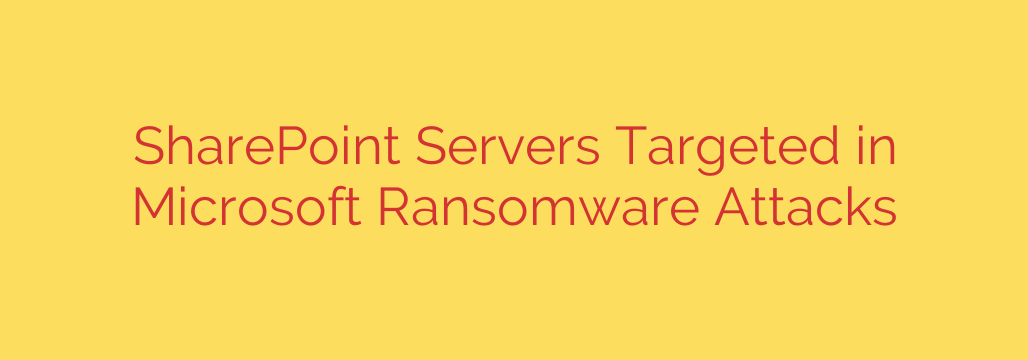
SharePoint Under Siege: How Ransomware is Exploiting a Critical Vulnerability
Microsoft SharePoint servers, a cornerstone of collaboration and data management for countless organizations, have become a prime target for sophisticated ransomware attacks. Cybercriminals are actively exploiting a critical vulnerability to gain complete control over servers, encrypt vital data, and demand hefty ransoms. If your organization uses on-premises SharePoint, understanding this threat is not just important—it’s essential for your operational security.
At the heart of these attacks is a critical privilege escalation vulnerability, tracked as CVE-2023-29357. This flaw, when exploited, allows an attacker to gain administrator-level privileges on a vulnerable server without needing to authenticate. In simple terms, a remote attacker can bypass all security checks and become the system’s all-powerful administrator, giving them the keys to your digital kingdom.
The Anatomy of the Attack
The attacks are often multi-staged, demonstrating a calculated approach by cybercriminals. Here’s how a typical breach unfolds:
Initial Access: The attack often begins with a classic phishing email. An employee receives a deceptive message, tricking them into clicking a malicious link or opening a compromised attachment. This initial foothold is all the attackers need to get inside your network.
Privilege Escalation: Once inside, the attackers scan the network for a vulnerable SharePoint server. Upon finding one, they exploit the CVE-2023-29357 vulnerability. This single step elevates their access from a standard user to a full administrator.
Ransomware Deployment: With complete administrative control, the attackers deploy their ransomware payload. They often use built-in system tools like PowerShell to execute malicious scripts, making the activity harder to detect. The ransomware then rapidly encrypts files across the SharePoint server and potentially other connected network drives.
Extortion: Finally, a ransom note is left behind. This note typically explains that the files are encrypted and demands a payment, often in cryptocurrency, in exchange for a decryption key. Prominent ransomware gangs, including the notorious LockBit group, have been linked to these types of attacks.
Are You at Risk?
This specific vulnerability affects several versions of the platform, including:
- Microsoft SharePoint Server 2019
- Microsoft SharePoint Server 2016
- Microsoft SharePoint Server Subscription Edition
The crucial point is that Microsoft released a patch for this vulnerability in its June 2023 Patch Tuesday updates. This means that any organization that has failed to apply these security updates is running a server with a publicly known, critical flaw that is being actively exploited. Attackers specifically hunt for these unpatched systems, as they represent the easiest targets.
Actionable Steps to Secure Your SharePoint Environment
Protecting your organization from this threat requires immediate and proactive measures. Complacency is not an option when dealing with active ransomware campaigns. Follow these critical security steps to fortify your SharePoint servers.
1. Patch Immediately: This is the most critical action you can take. If you have not already, apply the June 2023 and subsequent security updates from Microsoft without delay. Patching this vulnerability closes the primary door that attackers are using.
2. Implement Multi-Factor Authentication (MFA): While this vulnerability allows attackers to bypass some authentication, MFA is still a vital layer of defense. It makes the initial phishing stage of the attack significantly harder for criminals to succeed at.
3. Review Administrator Privileges: Adhere to the principle of least privilege. Regularly audit all accounts with administrative access to your SharePoint environment. Remove any unnecessary permissions to limit the potential damage an attacker can do if they compromise an account.
4. Monitor for Suspicious Activity: Keep a close watch on your server logs. Be vigilant for unusual PowerShell execution, the creation of new user accounts with high privileges, or large-scale file modification activity. These can be early indicators of a compromise.
5. Enhance Employee Training: Since these attacks often start with phishing, ongoing security awareness training is crucial. Educate your team on how to spot and report suspicious emails, reinforcing that they are the first line of defense against cyber threats.
The targeting of SharePoint servers is a stark reminder that even the most trusted platforms can become battlegrounds. By taking decisive action to patch vulnerable systems and strengthen your overall security posture, you can protect your critical data and ensure your organization does not become the next victim.
Source: https://www.bleepingcomputer.com/news/security/microsoft-sharepoint-servers-also-targeted-in-ransomware-attacks/








